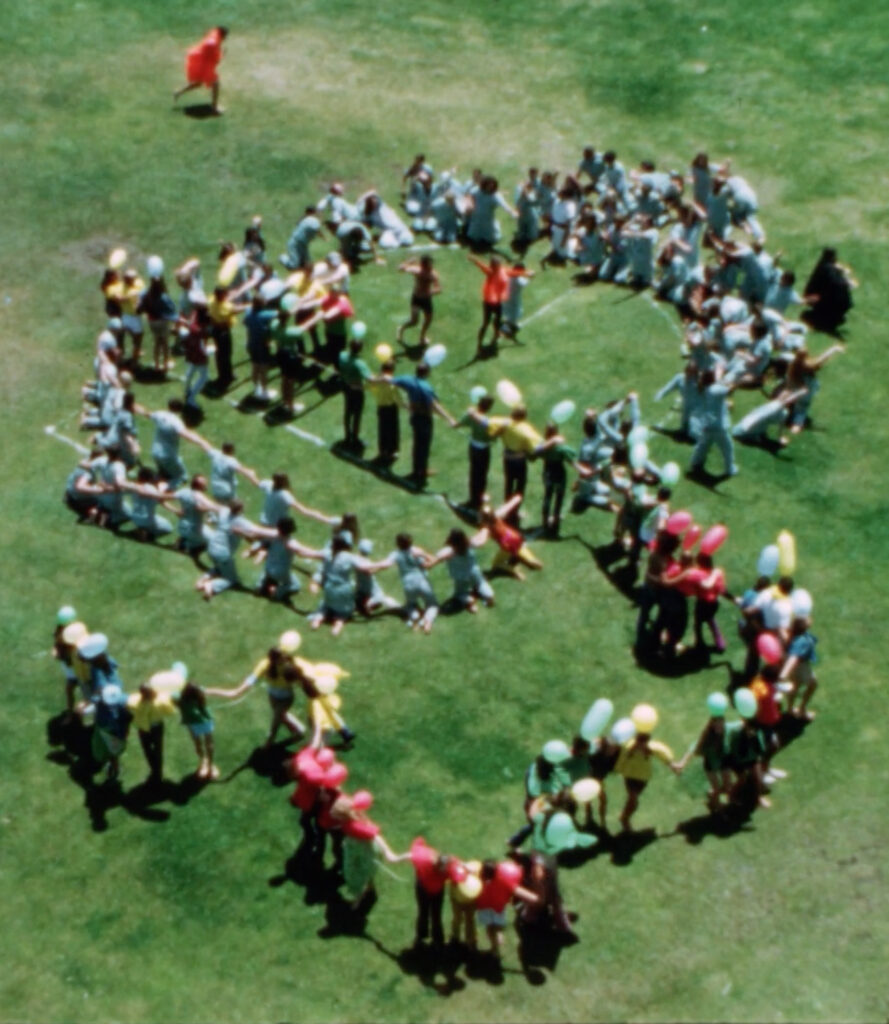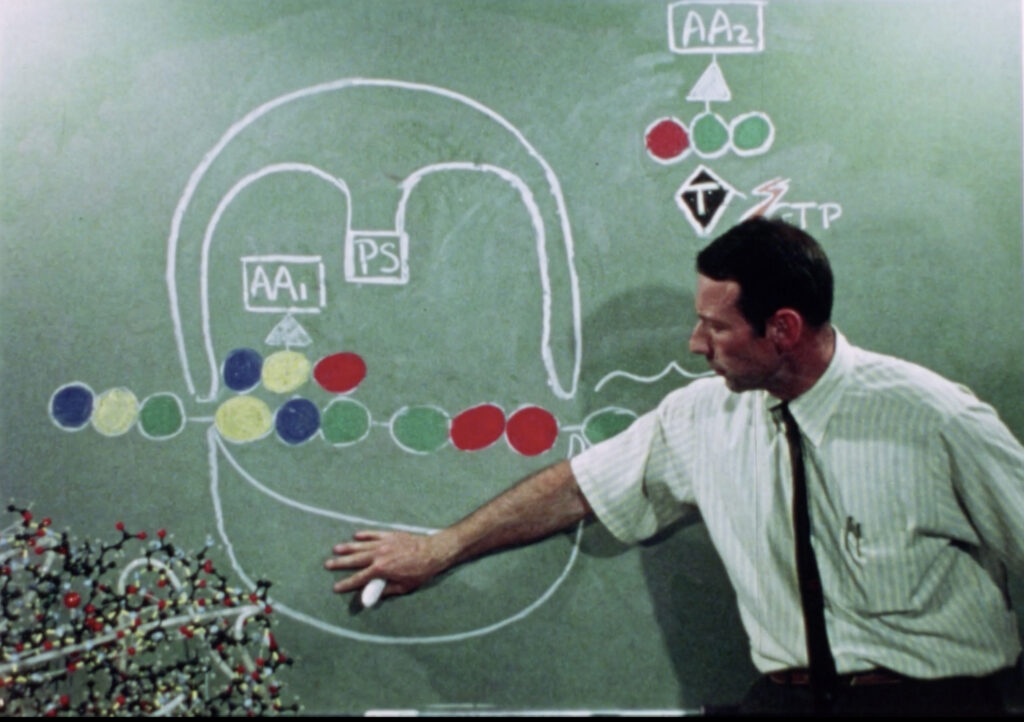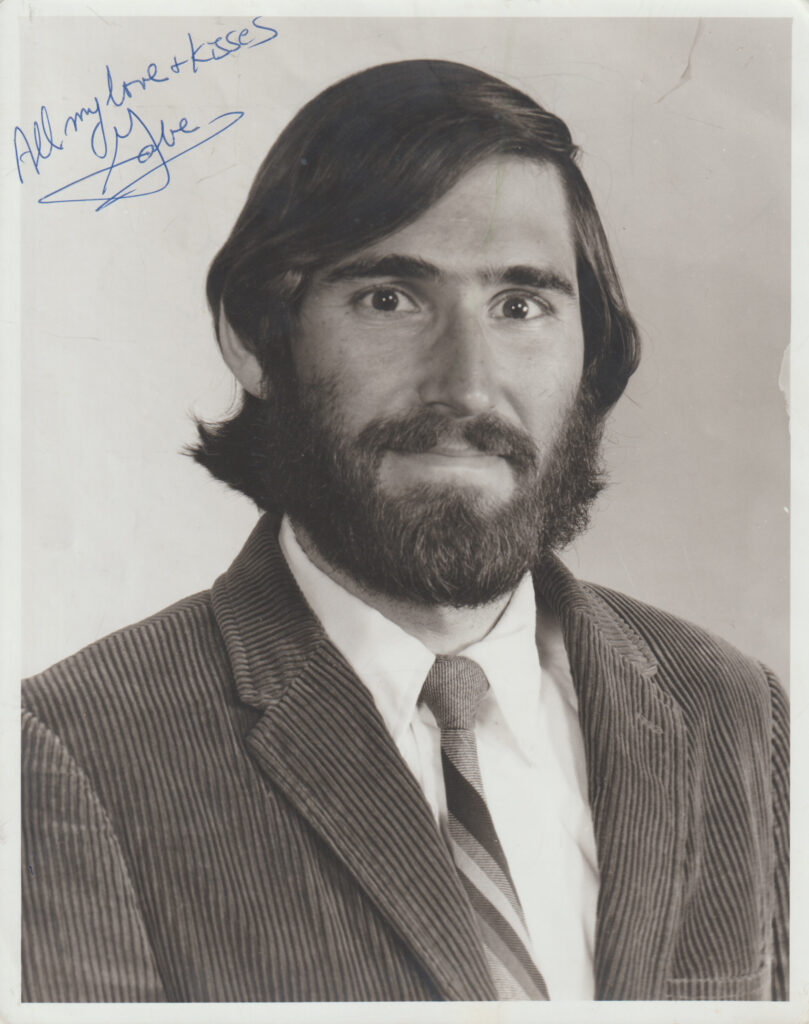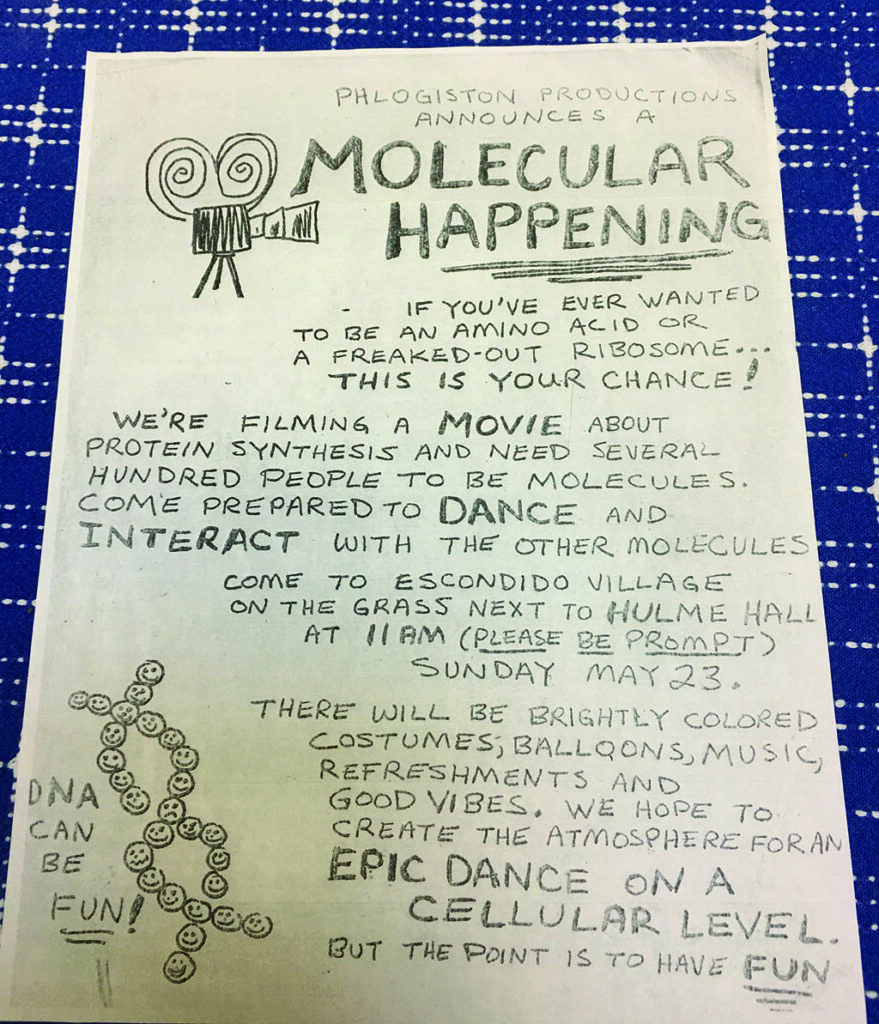‘And protein chain outgrabe’
The making of a ’70s cult classic that brings protein synthesis to life

‘All mimsy was mRNA
That colored message unit array
… All mimsy was mRNA
And protein chain outgrabe’
— Narration from the film Protein Synthesis: An Epic on the Cellular Level
While teaching a high-school biology course recently, I found myself reflecting on a low-budget movie that had delighted me as a graduate student decades before. The quirky 13-minute film in question, Protein Synthesis: An Epic on the Cellular Level, was produced on the Stanford University campus in 1971, with colorfully clad students depicting the roles of mRNA, tRNA, ribosomes, amino acids and translation factors, all while dancing to the beat of a psychedelic improv band.
Soon, I was down the rabbit hole, discovering an archival copy of the movie on the web to show my students. I couldn’t help but go deeper.
Protein Synthesis was the brainchild of Robert “Gabe” Weiss (MD ’75), a first-year medical student at the Stanford School of Medicine at the time. Weiss had a background in moviemaking from his days as an undergraduate at UC San Diego. There, he was an integral part of the Senses Bureau, the film-production unit of the lab of chemistry professor Kent Wilson, PhD.

Though Weiss and Wilson are both deceased, I was able to interview the remaining ringleaders, including Weiss’ wife, Jacquelyn (née Benington, BS ’73, MA ’75), and others who recalled with delight that singular time in their lives. Paul Berg, PhD, then chair of the Stanford School of Medicine’s Biochemistry Department and the film’s staid counterpoint to the gyrating bodies, also reminisced.
It was also a singular time in American history, as the nation was in an uproar over the Vietnam War. Gregory Redding (MD ’74), a friend of Weiss’ from UCSD and also a Stanford School of Medicine student, said they and their cohort opted for a future in medicine so they could qualify for the so-called “doctor draft.” (Until 1973, medical students were allowed to defer being drafted into the military until they completed medical school and their residency training).
In the spring of 1971, they enrolled in a biochemistry class, the most popular course in the medical school. Also in the class was Gordon Norman (AB ’70, MD ’74, MBA ’94) who was folded into the close-knit UCSD group, playing lunchtime volleyball with Weiss and Redding and jamming with them, UC San Francisco medical student William Corey and his brother, Paul, in San Francisco.
Video: Protein Synthesis:
An Epic on the Cellular Level
Film by the Senses Bureau at UC San Diego, from the university’s Digital Collections
Library. For best performance, download the video here.
Berg — who nine years later was awarded a 1980 Nobel Prize in chemistry — happened to be teaching the class that spring, and his lectures on protein synthesis ignited Weiss. Observed Norman, “I think he had been itching to make a movie about anything,” but when he saw Berg’s lecture, he knew this was his chance.
“Gabe was pretty cocky,” recalled Redding. “He told Berg that he needed to make the process more dynamic. And to his credit Paul said, ‘You think you can do better?’ We said, ‘Yeah.’ He said, ‘How are you going do that?’ ‘We’re going to make a movie!’”
Weiss, Redding, Norman and Gregory O’Leary (MA ’72), another San Diego friend and Stanford University graduate student in English, organized a planning council and recruited others to help.
“Gabe probably could have done this single-handedly, but he was inclined to do it as a collective activity. He was happy to have his friends involved,” said Norman. Ann Bailey (MA ’76, JD ’76), Norman’s girlfriend at the time and the film’s sweet-voiced narrator, put it more vividly. “Gabe was like a pied piper. You would follow this guy!”
Depicting protein synthesis
through dance
Weiss envisioned depicting protein synthesis through the medium of dance and enlisted Benington, who was a human biology major with extensive gymnastics, dance and performance experience, to join the project as its choreographer. She recalled being captivated not only by the project but also by Weiss. “I was totally smitten,” she said.

Weiss collaborated with Wilson to help produce the movie, but to pull it off, they needed funding to buy film. They turned to Berg.
“To put it in context,” Berg told me when I interviewed him last year, “you have to think about what was going on at Stanford at the time. In 1970-71, the campus was in an uproar about the Vietnam War. The students were skipping classes, out of the labs, attending sit-ins and protest marches. It was pretty grim.”
“I was chair of the [Biochemistry] Department, so I was engaged in all the departmental discussions about what was going on and how are we were going to handle it. Many of us were sympathetic to what the students were doing, but we had to keep the ship going.”
When Weiss and Norman approached Berg, they told him they saw the process as being very dynamic, with molecules moving in and out of the ribosome and so on.
“I thought they were pulling my leg! I was sort of very standoffish for a bit. ‘How do you intend to do this?’ I asked. ‘With people playing the part of molecules, out on a big green, and filming from high above in one of the student dormitories,’ they said.
“To suddenly have something that had a flavor of the old-time high jinks, where people would do funny things … maybe it could transform the mood on campus. So I said I would give them the money and to go ahead.”
Richard Palmiter, PhD, who was a pharmacology postdoc and played Elongation Factor 2 in the film, recalled when Weiss, whom he didn’t know, wandered into his lab seeking donations for the project. “I was intrigued with the idea. I think I gave him $100, and somehow that made me a producer!”
With the concept in place, funding secured and a venue selected, the committee recruited students and friends as performers, but they needed a bigger crowd. So O’Leary turned to the student newspaper, the Stanford Daily, to get the word out. In it, Joanne Jacobs (BA ’74) wrote, “Greg O’Leary and 15-20 fellow freaks hope to lure at least 200 people … with molecular acting ambitions” to Hulme lawn in Escondido Village the following Sunday morning, noting that, “Nobody knows for sure how long it will take.”
The main event
On May 23, a hoard of students arrived and the directors distributed assignments, costumes and brief instructions, saying, ‘“Here, you’re a ribosome, you’re an amino acid, you’re a tRNA,’” recounted Redding.
Berg was in attendance for the rehearsal. “They scheduled a teach-in,” he said. “It was done like football practice, out on the field. They were teaching them the role they had in this process of protein synthesis.” After this brief introduction, with costumes donned, bodies painted, and key dancers leading the way, the action and the filming began.

Jacquelyn Benington Weiss recalls racing to the top floor of Hulme Hall with cinematographer Noël Bartlett and Redding, knocking on doors of students who were studying for finals, to secure a balcony perch with a good view.
Once filming began, Gabe Weiss took his place on a ladder, barking through a bullhorn to control the human molecular traffic. With Bartlett secured on the balcony, cameraman Paul Savage filmed the ground shots, and Norman served as a cheerleader on the field.
For the choreography, Benington had tapped into Stanford University’s folk dance community, who formed the basis for the mRNA molecule. Three people, arms wrapped around each other and tethered by a rope, enacted triplet codons. Each base — guanine, adenine, uracil or cytosine — was identified by a colored pinny and matching balloon.
Three other dancers (the similarly arrayed triplet anticodons) depicted tRNA molecules, with coded amino acid dancers lashed together and prancing behind. When the tRNA entered the ribosome and met its cognate, the codons and anticodons joined hands to symbolize hydrogen bonding. Meanwhile, amino acids, identified by red body paint, held hands once the peptide bond was formed and were instructed: “Don’t let go!”
Jazz musician Jim Nadel (BA ’72, who later founded the Stanford Jazz Workshop), drummer Steve Savage and bassist Mark Weimer (BA ’92), kept the energy and beats going with what Nadel described as “very long jams” and “changing grooves to accommodate what was happening on the field.”
A phalanx of flexible folks — garbed in drab blue scrubs “borrowed” from operating rooms — constituted the two ribosomal subunits, 30S and 50S. Tumbling into the ribosome complex, defined on the field by chalk, the subunits clamped onto the mRNA, setting into motion production of the protein, then tumbled back out after it was completed.
Protein synthesis requires a few other factors, of course, and eye-catching costumes were worn to help viewers follow their roles in the process. Benington, for example, wore an orange leotard and yellow tights while performing the role of Initiator Factor 2.
Med student Hans Dankers (AB ’70, MD ’75) depicted GTP while wearing a red poncho and ski goggles. At Berg’s suggestion, he shot puffs of chemicals from a fire extinguisher to represent energy during key parts of the protein synthesis process — the formation of the peptide bond and at the indexing step.
Playing the straight man
The “happening” came to a close after a spirited day of rehearsal, performance and bacchanalia, but the filming wasn’t finished. The planning committee wanted Berg to provide an introduction, and they needed his segment to take place the next day while the film crew from San Diego was still in Palo Alto.
“They invoked that I had to explain the process of protein synthesis first and lead the audience to understand it was going to be done in the ‘dance idiom,’ as they referred to it. I was given three minutes’ time to present that whole story,” he said.
“So the night before my filming, I wrote a description, and they laughed me out of it. They said I had to do it without a script. So we arranged to use idiot cards — pieces of brown paper with 30-second bits of what I wanted to say were written out and hung from the ceiling,” Berg recalled. “My three minutes took me about seven hours! I made mistakes, I fumbled my words, I turned the wrong way to the blackboard and so on. It was a real joke.”
The scholarly presentation was a straight-laced affair, in stark contrast to the exuberant scene it would preface. There is Berg in a button-down shirt and narrow tie, with two pens in his pocket, neatly outlining the process in colored chalk on a green board.
“Only rarely is there an opportunity to participate in a molecular happening,” Berg began, playing the very model of an atomic age nerd. “You are going to have that opportunity, for this film attempts to portray symbolically, yet in a dynamic and joyful way, one of nature’s fundamental processes, the linking together of amino acids to form a protein. … This film, with people portraying molecules, using the dance idiom, tries to animate these two processes, the programming and assembly of a protein.”
Recalling Berg’s filming of the introduction, Redding said, “He was a really good sport.”
Moreover, because Berg would soon be internationally recognized during the debate over recombinant DNA, his contribution was probably crucial to the film’s success.
“I think a lot of the credit of the film’s long life goes to Dr. Berg for having embraced it and sanctioned it with the imprimatur of Stanford Department of Biochemistry,” said Norman.
‘Only rarely is there an opportunity to participate in a molecular happening. You are going to have that opportunity, for this film attempts to portray symbolically, yet in a dynamic and joyful way, one of nature’s fundamental processes, the linking together of amino acids to form a protein.’
– Paul Berg, PhD, said during an introduction in the film
With the filming finished and the spring term behind them, the team retreated to UCSD to produce the final film by trimming down the dance scenes, adding graphics to call attention to the key players and steps, and laying down audio tracks that rival the video itself in capturing the spirit of the times. Gabe Weiss appropriated Lewis Carroll’s Jabberwocky to spin the tale of protein synthesis, and Ann Bailey supplied the narration.
The group did not capture audio during the performance, so they produced a soundtrack, a ’70s psychedelic improvisation, dubbed Protein Jive Sutra, on guitars, electric organ, drums, cowbell, a flute obbligato and occasional trumpet. And to top it off, Weiss bleated out the names of molecules as they came into play, “T factor!” “Initiator Factor 2!” To this day, I cannot hear, or even read, the word “GTP” and not recall that voice.
Protein Synthesis: An Epic on the Cellular Level premiered at the Unicorn Theatre in La Jolla, California, in mid-fall of 1971 and was shown before the premiere of The Andromeda Strain the following January at Memorial Auditorium on the Stanford University campus, with author Michael Crichton in attendance.
Though Berg was out of town, his wife, Mildred, reported that the audience was already giggling during Berg’s explication in anticipation of what they were about to witness, especially as still shots of the whimsical dance had been inserted into his formal lecture.
After I rediscovered the film, I took a pilgrimage to Hulme Hall and the grassy field that still remain on the Stanford University campus and wondered how many people passing that way today have an inkling of the molecular happening that took place half a century ago.
I’m grateful to those who entrusted me with their memories of how this classic came to be. “I have to tell you, none of us were high for this,” said Redding. Thank you for clarifying.
And as for my high-school students, they were wide awake. “Far out!” was the word that came to mind.
Jane Gitschier, PhD, is a freelance science writer and a professor emeritus of medicine and of pediatrics at UC San Francisco. Contact her at jane.gitschier@ucsf.edu. Contact the editors at medmag@stanford.edu.
Editor’s note: Paul Berg, PhD, an emeritus professor of biochemistry at the Stanford School of Medicine, died Feb. 15, 2023, at age 96. Upon reading a draft of this article in December 2022, he wrote in an email: “I learned a great deal on reading it and relived some of the excitement of doing the project. … There was a time when the film was being shown in biology courses from middle school to graduate courses in genetics and biochemistry and even in post graduate education lectures to physicians. It was reviewed in Nature magazine for its educational value but never for its novelty and pure spoofiness.”
